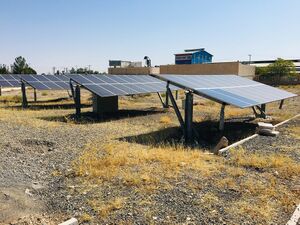
University of Kashan introduced this project and Seyyed Ali Sadat was the senior researcher in this work.
Project goals[edit | edit source]
- Studying the effect of dust on PV solar modules in Kashan desert environment
- Evaluation of the effectiveness of PV power plants construction in the Kashan region
- Prepare some data for University of Kashan
- Identify main barriers to development of PV energy in Iran
- Prepare practical solutions to overcome barriers in the context of PV development in Iran
Results[edit | edit source]
The experimental analysis of dust deposition effect on solar photovoltaic panels in Iran's desert environment[edit | edit source]
Sadat, S. A., Faraji, J., Nazififard, M., & Ketabi, A. (2021). The experimental analysis of dust deposition effect on solar photovoltaic panels in Iran's desert environment. Sustainable Energy Technologies and Assessments, 47, 101542.
Since soiling is a site-specific problem, this paper for the first time performs controlled experiments to determine the characteristics of a dust sample from the desert region of Iran and its impact on the power efficiency of solar photovoltaic modules. Dust characterization experiments are performed using scanning electron microscope, X-ray fluorescence, and elemental mapping. Elemental mapping tests, which have attracted little attention in photovoltaic soiling studies, will help researchers to investigate this phenomenon more accurately. For electrical evaluations, general relationships between losses caused by dust deposition and degradation of photovoltaic output parameters are obtained by testing different dust samples. The elemental results showed that the dust sample is mostly composed of Si, O, Al, and Ca elements. In addition, indoor experiments revealed that dust particles have different shapes and sizes (from 0.4 μm to 31 μm). When the dust density is increased from clean cell to almost dark shading conditions, it was observed that conversion efficiency, photovoltaic normalized maximum power, open-circuit current, and short-circuits current are decreased by 98.2% (non-linearly), 98.13% (non-linearly), 20.63% (linearly), and 98.02% (non-linearly), respectively. Furthermore, the results showed that soiling process has no significant impact on fill factor due to uniform dust dispersion on PV module.
Barrier analysis of solar PV energy development in the context of Iran using fuzzy AHP-TOPSIS method[edit | edit source]
Sadat, S. A., Fini, M. V., Hashemi-Dezaki, H., & Nazififard, M. (2021). Barrier analysis of solar PV energy development in the context of Iran using fuzzy AHP-TOPSIS method. Sustainable Energy Technologies and Assessments, 47, 101549.
The development of renewable energy systems could be facilitated by appropriate energy policies according to the recognition of major barriers. Iran, with over 1,648,000 sq. km of suitable area and 300 sunny days per year, and over 2200 kWh/m2 of irradiation, has one of the highest potentials for utilization of solar energy on the planet. However, achieving the goals of renewable energy development based on Iranian roadmaps encounters various barriers. On the other hand, there is a research gap for conducting a comprehensive study by considering multiple-criteria decision-making (MCDM) methods and qualitative methods under uncertainty in investigating the barriers of photovoltaic developments. By combining Fuzzy MCDM methods and qualitative analysis ones, this study aims to respond to this research gap, particularly for the barriers facing Iran's photovoltaic energy production development. This paper assesses the barriers based on Fuzzy analytic hierarchy process (Fuzzy-AHP) techniques. The Fuzzy-TOPSIS method is also used to determine how it is possible to overcome the challenges. The results imply that "messy economic situation" and "ineffective bureaucracy" are the most barriers hampering the development of photovoltaic energy production in Iran. Moreover, "Economic and financial incentives" and "mitigating bureaucratic efforts for permission approval" are the most effective solutions.
References[edit | edit source]